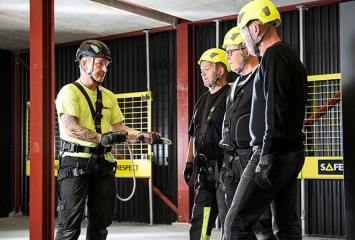

Fall Protection Training Courses are essential for ensuring the safety of workers who may be exposed to fall hazards in various work environments, particularly in construction and maintenance. These courses are designed to educate employees on the proper use of fall protection equipment, safe work practices, and emergency procedures to minimize the risk of falls.
- Understand Regulatory Requirements
- Comprehend OSHA standards and regulations related to fall protection.
- Identify employer and employee responsibilities under these regulations.
- Recognize various types of fall hazards in the workplace.
- Conduct hazard assessments to identify potential fall risks.
- Learn about different fall protection systems, including guardrails, safety nets, and personal fall arrest systems.
- Understand the proper selection, use, and limitations of fall protection equipment.
- Perform regular inspections of fall protection equipment.
- Identify signs of wear and damage and understand maintenance procedures.
- Develop and follow safe work procedures to minimize fall risks.
- Use ladders, scaffolds, and other equipment safely.
- Understand procedures for responding to fall incidents.
- Learn rescue techniques for assisting fallen workers.
- Foster a culture of safety and awareness among workers.
- Encourage reporting of unsafe conditions and proactive safety measures.
- Introduction to Fall Protection
- Importance of fall protection in the workplace
- Overview of fall-related statistics and regulations
- Understanding the consequences of falls
- Regulatory Standards
- Overview of OSHA fall protection standards (29 CFR 1926/1910)
- Responsibilities of employers and employees
- Importance of compliance with safety regulations
- Identifying Fall Hazards
- Common fall hazards in various industries (construction, maintenance, etc.)
- Risk assessment techniques to identify potential fall risks
- Importance of hazard recognition and reporting
- Fall Protection Systems and Equipment
- Types of fall protection systems (guardrails, safety nets, personal fall arrest systems)
- Proper use and maintenance of fall protection equipment
- Inspection procedures for fall protection gear
- Safe Work Practices
- Best practices for working at heights
- Procedures for using ladders and scaffolding safely
- Importance of communication and teamwork in fall prevention
- Emergency Procedures
- Steps to take in the event of a fall
- First aid and rescue procedures
- Importance of emergency response planning
- Practical demonstrations of fall protection equipment usage
- Review of key concepts covered in the course
- Employers and Supervisors:Those responsible for implementing and overseeing fall protection programs.
- Managers and supervisors who need to ensure compliance with safety regulations.
- Safety officers and professionals tasked with maintaining workplace safety.
- Individuals responsible for conducting safety audits and inspections.
- Workers at Height
- Workers using ladders, scaffolds, aerial lifts, and other equipment.
- First responders and rescue team members.